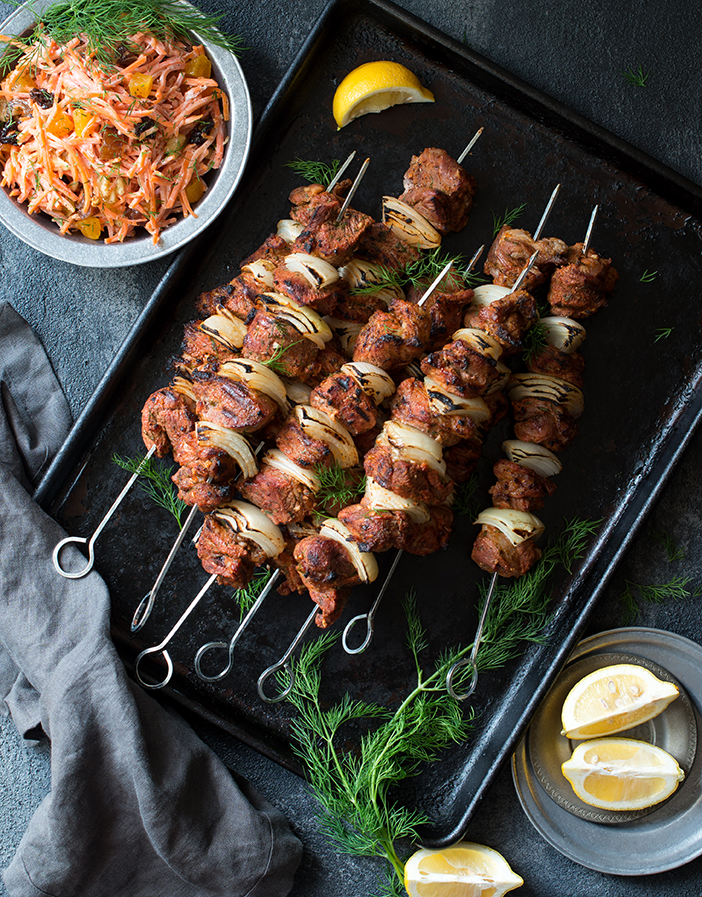In each issue of Paleo Magazine, I share the history of a traditional recipe and adapt it to fit into a healthier paleo lifestyle. For...
Read MoreShashlik (a.k.a., shish kebabs)
In each issue of Paleo Magazine, I team up with Steph Gaudreau to share the history of a traditional recipe and adapt it to fit into a healthier paleo lifestyle. (I write the words; she makes the gorgeous photos.) In a previous column, we took a historical look at everybody’s favorite protein: meat on a stick.
Let’s just agree right out of the gate that there is nothing as satisfying, fun, or inherently primal to eat than meat on a stick, a.k.a., shish kebabs. They’re usually cooked over some kind of open fire, so there are all those irresistible, charred, crispy bits—and kebabs in all their various forms consistently show up in boisterous places: carnivals, street carts, family cookouts, summer holidays, and camping adventures. Bonus: It’s generally accepted practice to eat shish kebabs with your hands, lick your fingers, and, if the spirit moves you, maybe howl at the moon. What dining experience is better than that?!
We should expect nothing less from a dish that was reportedly created when Turkic tribes, marauding from Central Asia to Anatolia, used their swords to roast cubes of meat over open fires. The romance of that image aside, some argue the first recorded mention of shish kebabs can be found in Homer’s Odyssey:
There sat Nestor among his sons as friends around them
decked the banquet, roasted meats and skewered strips for broiling
Whatever the origin, there’s no denying that meat on a stick has long been a popular and manly meal all over the world.
We’re going to leap forward in time now to 16th century Russia and Ukraine to check in with the Cossacks. Their kebabs were known as “shashlyk” and were cooked over wood fires that imparted a delightfully smoky flavor to the meat. Traditionally, the kebabs were made from lamb that had been marinated in wine and spices to tenderize it and to disguise its gamier notes. By the early 20th century—just in time for the Russian revolution—the kebabs were a staple in Moscow, St. Petersburg, and other soon-to-be-Soviet cities. Shashlik was one of the few traditional Russian dishes to make it through the Bolshevik revolution relatively unchanged.
According to lore, Leonid Brezhnev—the ruler of the USSR from 1964 until he died in 1982—was a devoted hunter and enthusiastic consumer of shashlik. He lead parties of political leaders and dignitaries, including cosmonaut Yuri Gagarin, to track deer in the hunting grounds near Moscow. Then, after a day of tromping about in the woods, they’d return to civilization for a feast of marinated kebabs, salads, and—of course—plenty of vodka.
But shashlik was the great equalizer and was enjoyed by Soviet citizens throughout the vast expanse of the USSR. As Olga and Pavel Syutkin wrote in the CCCP Cook Book, “…sinking your teeth into juicy chunks of skewered lamb or beef was like a dream for many Soviet citizens.”
Whether at a backyard barbecue, an urban food truck, or a camping trip in the Caucasus, shashlik is usually accompanied by simple salads of fresh vegetables. Although Russian cooks argue about the best marinades—wine versus lemon juice versus vinegar—their tradition grudgingly acknowledges that meat on a stick, cooked over a searing flame, is one of the finest ways to bring people together in celebration of food and life.
For our recipes, we’ve opted for lamb and a lemon-and-seltzer based marinade to tenderize the meat and infuse it with the earthy spices. The marinade will work equally well with cubes of pork or chicken, if you prefer. For the side salad, we adapted a sweetly crunchy combination of carrots and dried fruit. And to you we say, Prijatnovo appetita!
Shashlik & Carrot Salad
Serves 4-6 | Prep 15 minutes | Marinate 2 hours | Cook 15 minutes | Whole30 compliant
Ingredients:
Shashlik Marinade:
1/2 cup seltzer water
2 tablespoons lemon juice
1/4 cup fresh dill, minced
4 cloves garlic, minced
2 bay leaves
4 teaspoons ground paprika
1 teaspoon ground coriander
1 teaspoon ground cumin
1 teaspoon salt
1/2 teaspoon ground black pepper
Lamb Kebabs:
1 1/2 pounds boneless lamb leg or shoulder, cut into 2-inch pieces
3 small yellow onions, cut into eighths
Carrot Salad
1-2 tablespoons homemade mayo
1 tablespoon honey (optional; omit for Whole30)
pinch salt
pinch ground black pepper
3 large carrots, peeled and grated
1/3 cup raisins, minced dried apricots, or chopped dates (or a mix of all three)
1/2 cup walnuts, chopped
Directions:
Marinate the lamb. Place the marinade ingredients in a glass bowl and whisk to combine. Add the lamb, toss to coat, and marinate at least 2 hours or up to overnight.
Prep the salad. In a large bowl, place mayo, honey, salt, and pepper. Whisk to combine. Add carrots, dried fruit, and walnuts, then toss until coated with dressing. Allow the flavors to meld in the fridge while the lamb marinates. When it’s time to cook the lamb, let the salad come to room temperature.
Cook the kebabs. When you’re ready to eat, thread the meat and onions onto skewers.
To cook on a gas grill: Preheat the grill on high with the lid closed until very hot, about 10-15 minutes. Grill the skewers uncovered, turning every 1-2 minutes, until lamb is cooked to desired doneness, 7-8 minutes total for medium-rare to medium.
To broil in the oven: Heat broiler on high. Place the skewers on a broiler pan and broil, flipping once, until the cubes are evenly browned but still pink in the middle, about 2-4 minutes per side.
To roast in the oven: Preheat oven to 375F. Place skewers on a baking sheet and roast, flipping once, until the cubes are evenly browned, about 12 minutes for medium-rare or 15 minutes for medium to medium-well.
For more delicious recipes like this one, subscribe to Paleo Magazine.
Still hungry? Try these
In each issue of Paleo Magazine, I team up with Steph Gaudreau to share the history of a traditional recipe and adapt it to fit into a...
Read More





We received some humongous, extra long skewers from Russia as a wedding gift and haven’t used them yet. It seems appropriate that this would be the maiden recipe for us to use. I can’t wait to fire up the grill!